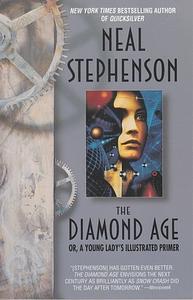Take a photo of a barcode or cover
Just not my cup of tea. I'm technologically illiterate so it's hard to get excited about a book with a nano-technological future as the plot base. The drummer society weirded me out a little bit. Meh.
Reread after 20+ years. Holds up pretty well. A bit chaotic towards the end
As usual I'm late to the party. The diamond age was released in 1995 and follows closely after [b:Snow Crash|40651883|Snow Crash|Neal Stephenson|https://i.gr-assets.com/images/S/compressed.photo.goodreads.com/books/1589842551l/40651883._SX50_.jpg|493634] from 92, which i read 10 years ago, in the meantime i have read [b:The Baroque Cycle Collection|22535547|The Baroque Cycle Collection|Neal Stephenson|https://i.gr-assets.com/images/S/compressed.photo.goodreads.com/books/1407110757l/22535547._SX50_.jpg|50643684] , [b:Reamde|10552338|Reamde|Neal Stephenson|https://i.gr-assets.com/images/S/compressed.photo.goodreads.com/books/1305993115l/10552338._SY75_.jpg|15458989] and [b:Cryptonomicon|816|Cryptonomicon|Neal Stephenson|https://i.gr-assets.com/images/S/compressed.photo.goodreads.com/books/1327931476l/816._SY75_.jpg|1166797], which was all brilliant, so how does a 25 years old cyber punk novel holds up ?, the short answer is - Amazingly well.
In a near future world where nanotech has made away with real poverty, as everything, including food can be produced by matter converters, but where the diversion between the upper and lower classes are larger than ever. The world is divided into large tribes, based more on cultural preferences than physical boundaries, with the Neo-Victorians, a throwback to the British Victorian age, as one of the leading tribes.
We follow the young poor girl Nell, who by mistake gets har hands on the "Primer", an advanced AI-like role-playing-game, built with the purpose of educating a child towards higher independence.
Stephenson's fascination with the RPG game format is clear and will be explored further in [b:Reamde|10552338|Reamde|Neal Stephenson|https://i.gr-assets.com/images/S/compressed.photo.goodreads.com/books/1305993115l/10552338._SY75_.jpg|15458989], here he uses it expertly to show Nell's development and bring the storyline forward. What's also fascinating is the underlying implication that for all the Primer's brilliance and AI-sophistication it's the human persona behind the scene "Miranda", who brings it to life.
In a near future world where nanotech has made away with real poverty, as everything, including food can be produced by matter converters, but where the diversion between the upper and lower classes are larger than ever. The world is divided into large tribes, based more on cultural preferences than physical boundaries, with the Neo-Victorians, a throwback to the British Victorian age, as one of the leading tribes.
We follow the young poor girl Nell, who by mistake gets har hands on the "Primer", an advanced AI-like role-playing-game, built with the purpose of educating a child towards higher independence.
Stephenson's fascination with the RPG game format is clear and will be explored further in [b:Reamde|10552338|Reamde|Neal Stephenson|https://i.gr-assets.com/images/S/compressed.photo.goodreads.com/books/1305993115l/10552338._SY75_.jpg|15458989], here he uses it expertly to show Nell's development and bring the storyline forward. What's also fascinating is the underlying implication that for all the Primer's brilliance and AI-sophistication it's the human persona behind the scene "Miranda", who brings it to life.
the first half of the book is, as usual, much better than the second half. I really can't stand Stephenson's depiction of women, though young Nell is a great protagonist. Interested in the concept & general idea of the novel, the questions generated by the "ractive" and primer (Hamlet on the Holodeck, anyone?) but totally lost once the time jump happens.
This my seventh Neal Stephenson book, though it has been a little while.
It made me remember why I was so fond of him as an author: his nerdy, well-researched backdrops make for some consistently amazing world-building. In the case of The Diamond Age, Stephenson lets his imagination loose on a world altered irrevocably by nanotechnology. He explores the consequences in a kaleidoscope of different ways.
* Matter compilers -- essentially sophisticated 3D printers are ubiquitous and are perfectly capable of meeting humans' every need.
* Even with the aforementioned MC's, Star Trek this is not. Social stratification still exists, nation-states collapsed from an inability to tax citizens and maintain control, and humanity fell back largely into organizations of ethnic groups or "phyles."
* Nanomites of various kinds are everywhere in the water, the air, in food and bodily fluids. They can do all the things you would hope or fear: tracking, curing, killing, interfacing, etc.
* They're even capable of interfacing with the human brain, enabling a cult of "Drummers" to live autonomously underwater as a sort of hybrid hive mind.
I feel like Stephenson could have gotten hung up on some more simple applications of nanotechnology. And indeed, that was my fear in the early going. But instead his premise lead him in a lot of surprising directions that feel like they had the air of plausibility. Stephenson opted to focus on cultural and sociological consequences of these developments and it makes for a much more interesting book.
There's not a lot I can say about the plot without giving spoilers, but suffice to say it revolves around an adaptive piece of educational technology called "A Young Lady's Illustrated Primer" and Nell, the girl who is introduced to it early in life.
What ensues is strange and sort of unpredictable. I wouldn't call it the most satisfying narrative ever once it winds its way to its conclusion, but I gave it five stars anyway because I just enjoyed being part of this universe for as long as I was.
It made me remember why I was so fond of him as an author: his nerdy, well-researched backdrops make for some consistently amazing world-building. In the case of The Diamond Age, Stephenson lets his imagination loose on a world altered irrevocably by nanotechnology. He explores the consequences in a kaleidoscope of different ways.
* Matter compilers -- essentially sophisticated 3D printers are ubiquitous and are perfectly capable of meeting humans' every need.
* Even with the aforementioned MC's, Star Trek this is not. Social stratification still exists, nation-states collapsed from an inability to tax citizens and maintain control, and humanity fell back largely into organizations of ethnic groups or "phyles."
* Nanomites of various kinds are everywhere in the water, the air, in food and bodily fluids. They can do all the things you would hope or fear: tracking, curing, killing, interfacing, etc.
* They're even capable of interfacing with the human brain, enabling a cult of "Drummers" to live autonomously underwater as a sort of hybrid hive mind.
I feel like Stephenson could have gotten hung up on some more simple applications of nanotechnology. And indeed, that was my fear in the early going. But instead his premise lead him in a lot of surprising directions that feel like they had the air of plausibility. Stephenson opted to focus on cultural and sociological consequences of these developments and it makes for a much more interesting book.
There's not a lot I can say about the plot without giving spoilers, but suffice to say it revolves around an adaptive piece of educational technology called "A Young Lady's Illustrated Primer" and Nell, the girl who is introduced to it early in life.
What ensues is strange and sort of unpredictable. I wouldn't call it the most satisfying narrative ever once it winds its way to its conclusion, but I gave it five stars anyway because I just enjoyed being part of this universe for as long as I was.
adventurous
mysterious
slow-paced
Plot or Character Driven:
A mix
Strong character development:
No
Loveable characters:
No
Diverse cast of characters:
Yes
Flaws of characters a main focus:
No
I liked this very much! This novel revisits my favorite Stephenson setting (a future similar to the one in Snow Crash) and twists it up with his clear penchant for historical-ish fiction and archaic social mores (as demonstrated in the Baroque Cycle). Also, it's under 500 pages, which I think should probably be the upper limit for a Stephenson book - Anathem notwithstanding, he often goes on for much too long. 400-ish pages means this novel is chock full of great details without sacrificing the pace of the plot.
All of that said, I personally forbid Stephenson from writing ANY MORE NOVELS that feature cryptology and/or alchemy. Enough already!
All of that said, I personally forbid Stephenson from writing ANY MORE NOVELS that feature cryptology and/or alchemy. Enough already!
WOW. That really sums up this book. It kept taking me down trails I thought I knew so well but then would veer off into the wilds in believable manners. It has a wonderful cast of characters that gotten woven into a brilliant design of a story with just enough information to get us to face-plant from cockiness.
adventurous
challenging
informative
mysterious
slow-paced
Plot or Character Driven:
Plot
Strong character development:
Yes
Loveable characters:
Yes
Diverse cast of characters:
Complicated
Flaws of characters a main focus:
No
adventurous
funny
hopeful
lighthearted
mysterious
tense
slow-paced
Plot or Character Driven:
A mix
Strong character development:
Yes
Loveable characters:
Complicated
Diverse cast of characters:
No
Flaws of characters a main focus:
Yes


